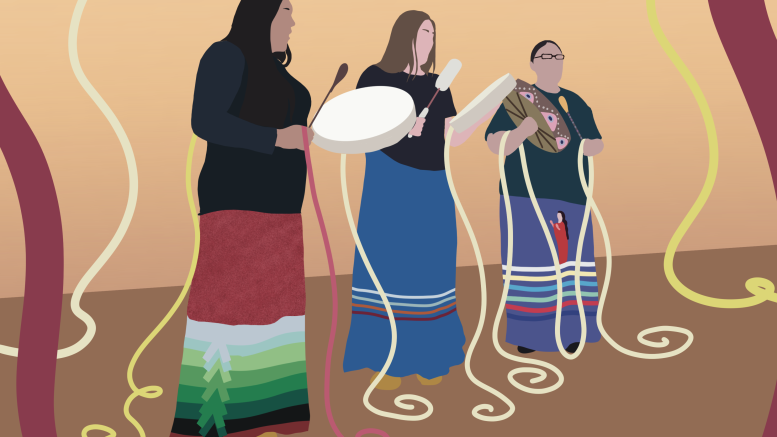Ongomiizwin is an Anishinaabe word that means “clearing a path for generations to come.”
It is also the name of the U of M’s Indigenous Institute of Health and Healing. Founded in 2017, Ongomiizwin combines three sections of the Max Rady college of medicine: the Manitoba First Nations Centre for Aboriginal Health Research, the Centre for Aboriginal Health Education, and the J.A. Hildes Northern Medical Unit.
Ongomiizwin is “the bringing together of some longstanding units,” said Melanie MacKinnon, head of the institution. “We have that longstanding history and foundation to build upon.”
The institution aims “to support Indigenous communities in the full expression of their self-determination.”
MacKinnon noted that Ongomiizwin was created following calls to action made by the Truth and Reconciliation Commission of Canada. These calls to action included respecting traditional Indigenous knowledge and healing practices, “removing barriers to health professional education for Indigenous students and educating students and faculty in cultural safety and anti-racism.”
“Our work in anti-Indigenous racism and cultural safety is nationally recognized,” MacKinnon said. “Our work in clinical outreach and medical services is also nationally recognized.”
She noted that Ongomiizwin is unique in its work as an academic institution supporting northern health and access to clinical services. Their work incorporates both health and education.
“The work is generational work, as it’s been generations of residential school experiences for survivors and ancestors,” MacKinnon said. “We understand that it’s also collective work and responsibility and it’s not the responsibly of solely Indigenous health leaders to respond to the needs of our community.”
“That is a systems approach,” she explained.
In a report titled “Guiding Voices,” Ongomiizwin’s Indigenous advisory council discussed goals for the platform.
They highlighted that Indigenous people in Canada are disproportionately impacted by illness, injury and death. Yet despite racial disparities in health care being well-established, the treatment provided by health-care systems to racialized people is not regularly measured. There is no system to collect racial or ethnic identifiers during a patient’s health-care encounter.
To combat this, the report suggested “a focused effort in collecting and monitoring healthcare system data in order to identify where disparities exist.”
The report identified health inequity, health disparity and racial health-care disparity as three important concepts that relate to the quality of health care experienced by Indigenous people.
They also noted that many health-care quality improvement measures widen gaps in health-care equity due to institutional racism. Improvements in health care are often focused on advantaged members of the population, rather than marginalized groups.
“A focus on health inequities is critical in the desire to achieve a health-care system that provides equitable high quality healthcare for every person,” the report stated.
In 2022, Ongomiizwin published the “Indigenous Healthcare Quality Framework” in partnership with Indigenous Healthcare Quality Leads and the George & Fay Yee Centre for Healthcare Innovation.
The framework highlighted the dimensions required to provide high-quality health care to Indigenous people. Patients and their families should feel validated, trusted and respected. Providers should be nonjudgemental, compassionate, attentive and culturally safe. The overall health-care system, the framework emphasizes, should be accessible, collaborative, flexible and approachable.
The framework is rooted in Joyce’s Principle, a call to guarantee Indigenous people equitable and non-discriminatory access to social and health-care services. The principle takes its name after Joyce Echaquan, an Indigenous woman whose experience with racism in health care contributed to her death. Echaquan was at the hospital when she raised concerns of heart palpitations. The medical staff made the unfounded assumption that she was suffering from withdrawal and failed to provide her with appropriate treatment. A coroner’s inquiry states that this treatment by health-care workers contributed to her death.
Echaquan’s coroner, Gehane Kamel, acknowledged the role racism played in her death, stating that she believed Echaquan would be alive if she were white.
Following the inquiry into her death, Kamel told Echaquan’s family that “a small revolution of reconciliation” had begun, and that her death would not be in vain.
The role of institutions like Ongomiizwin is to foster efforts toward this revolution.
“Our role is helping to bridge and facilitate that collective work,” MacKinnon said, “whether that be through cultural safety, anti-Indigenous racism […] exemplary clinical services, or role modelling what system change and modernized programs would look like.”
“I think the university community should be proud of the work of the institution and its national recognition and standing and how we have designed ourselves to be reflective of the communities that we serve.”


